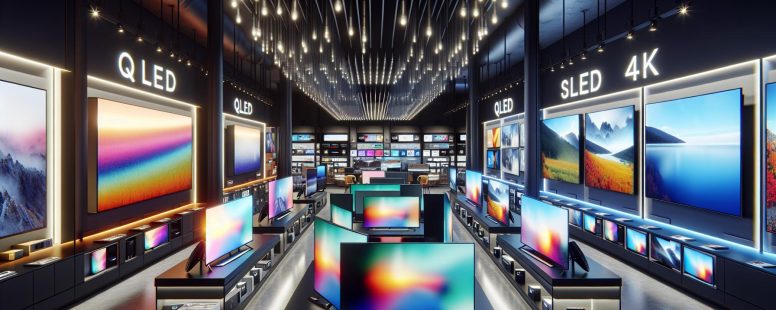Difference Between QLED and 4K: Which TV Technology is Right for You?
Picture walking into an electronics store, surrounded by dazzling displays and vibrant screens, each vying for your attention. You spot terms like “QLED” and “4K” plastered across sleek TVs, but what do they really mean? Choosing the perfect TV can feel like decoding a tech puzzle, especially when these buzzwords sound so similar yet promise different viewing experiences.
What Is QLED?
QLED, or Quantum Dot Light Emitting Diode, refers to a display technology developed by Samsung. It enhances picture quality using quantum dots, which are tiny semiconductor particles.
Key Features Of QLED Technology
- Quantum Dots: These nanoparticles emit precise colors when exposed to light. They produce brighter and more vibrant images compared to traditional LED displays.
- Backlighting: QLED uses LED backlights rather than self-emissive pixels (like OLED). This creates higher brightness levels but limits perfect black performance.
- HDR Support: Most QLED TVs support High Dynamic Range (HDR), enhancing contrast and color accuracy for a lifelike viewing experience.
- Wide Color Gamut: Quantum dots enable broader color ranges, making it ideal for content with rich visual details.
For instance, when watching nature documentaries on a QLED TV, greens of forests and blues of oceans appear vivid without oversaturation.
Advantages Of QLED
- Brightness Levels: With peak brightness reaching up to 2000 nits in some models, QLED excels in well-lit rooms where darker screens might struggle.
- Durability: Unlike OLED panels prone to burn-in issues over time due static images; QLED offers stability even during extended usage periods.
- Size Availability: Manufacturers produce larger screen sizes in the QLED category at competitive prices compared to OLED counterparts.
If you’re into gaming or sports broadcasting, these benefits make it an attractive option due its superior motion handling and longevity.
What Is 4K?
4K refers to a display resolution characterized by approximately 4,000 horizontal pixels. It delivers sharper, more detailed visuals compared to lower resolutions like Full HD (1080p).
Understanding 4K Resolution
The term “4K” typically corresponds to a resolution of 3840 x 2160 pixels in consumer TVs. This provides over eight million total pixels on the screen. Each pixel contributes to increased detail and clarity, especially on larger displays. For example, when watching movies or nature documentaries, textures and fine details appear crisp.
Digital cinema standards use slightly higher resolutions at 4096 x 2160 pixels, which is why it’s sometimes referred to as “Cinema 4K.” Regardless of the variant, both offer enhanced image quality over standard HD formats.
Benefits Of 4K Technology
- Enhanced Image Clarity
The high pixel count ensures images remain sharp even when viewed up close. This is particularly noticeable in action scenes or highly detailed shots.
- Improved Streaming Quality
Many streaming platforms such as Netflix and Amazon Prime provide content in native 4K resolution. Movies and series benefit from additional depth and realism.
- Better Gaming Experience
Gamers using consoles like the PlayStation 5 or Xbox Series X use the full potential of 4K for immersive gameplay with vivid graphics.
- Future-Proofing Your TV
With increasing availability of native 4K content across media platforms, adopting this technology keeps you aligned with current trends in home entertainment systems.
Key Differences Between QLED And 4K
Understanding the distinctions between QLED and 4K helps you make an informed TV purchase. Each term addresses a unique aspect of television technology, from display type to resolution.
Display Technology
QLED represents a display technology that relies on quantum dots to improve brightness and color accuracy. This innovation comes from Samsung but is now adopted by other brands like TCL and Hisense. Quantum dots interact with LED backlights, creating vivid colors and deep contrasts. In contrast, 4K refers not to how the image is created but to its pixel density—offering sharper details through higher resolution.
For example, while QLED focuses on enhancing visual quality using light emission techniques, 4K ensures images appear crisp by packing over eight million pixels into the screen. A QLED TV can also be 4K-compatible; but, not all 4K TVs use quantum dot layers.
Picture Quality And Resolution
Picture quality in QLED TVs benefits from enhanced HDR performance and better brightness levels compared to standard displays. These features make content look vibrant even under bright lighting conditions. Meanwhile, a TV’s resolution determines its clarity; with 3840 x 2160 pixels defining a typical 4K screen.
When comparing the two technologies directly: A non-QLED 4K TV might struggle with producing equally rich colors or contrasts as a QLED model while maintaining similar resolutions. For instance, watching wildlife documentaries may feel more immersive on QLED due to lifelike textures made possible by quantum dots combined with high-resolution output.
Should You Choose QLED Or 4K?
Choosing between QLED and 4K depends on your viewing preferences, budget, and the type of content you enjoy. Both technologies offer unique advantages that cater to different needs.
Factors To Consider
- Picture Quality
If vibrant colors and high brightness matter most, QLED TVs deliver exceptional performance. Quantum dot technology enhances HDR content, making scenes look lifelike even in brightly lit rooms. On the other hand, 4K resolution ensures sharper visuals with detailed textures, ideal for large screens or close viewing distances.
- Content Availability
Streaming platforms like Netflix and Disney+ now feature extensive 4K content libraries. But, not all shows use advanced picture enhancements found in QLED TVs. For sports enthusiasts or gamers who value motion clarity and color accuracy, QLED may provide a more immersive experience.
- Viewing Environment
In well-lit rooms where glare is a concern, QLED’s superior brightness levels outperform regular 4K displays. Conversely, in darker settings like home theaters, 4K OLED TVs might achieve deeper blacks but often at a higher cost than equivalent-sized QLED models.
Buyer Recommendations
- For Movie Buffs: A non-QLED 4K TV suffices if you’re focused solely on sharp resolution for films without needing enhanced vibrancy.
- For Gamers: Opting for a QLED TV with low input lag supports smoother gameplay experiences while preserving visual quality.
- For Budget Shoppers: Standard 4K models are generally more affordable unless additional features like quantum dots justify the investment.
- For Long-Term Use: Since many broadcasters transition toward higher resolutions paired with HDR formats, investing in future-proofed tech like a QLED-compatible device balances longevity against upfront costs.
Conclusion
Deciding between QLED and 4K eventually comes down to what matters most to you. Whether it’s the vibrant colors and brightness of QLED or the crisp resolution of 4K, each option offers unique advantages tailored to different preferences. Evaluating your content habits, budget, and viewing environment will help narrow down the best choice for your entertainment setup. By understanding these differences, you’re better equipped to invest in a TV that enhances every moment on screen.
- GDP Versus GNP: Understanding the Key Differences - November 14, 2025
- Which Is Best: CV or Resume? Understanding the Differences - November 14, 2025
- Which Is Best: ECE or CSE? - November 14, 2025







